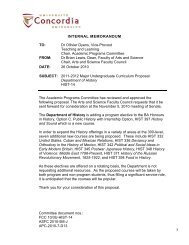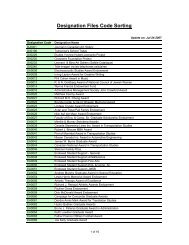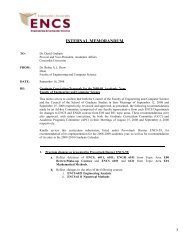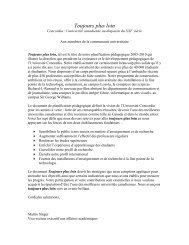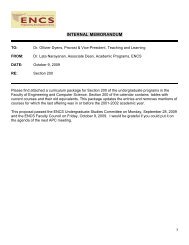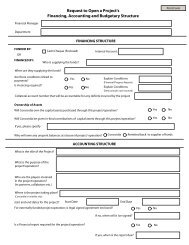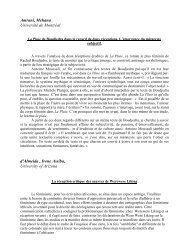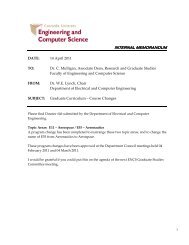Susan Landau-Chark - Concordia University
Susan Landau-Chark - Concordia University
Susan Landau-Chark - Concordia University
You also want an ePaper? Increase the reach of your titles
YUMPU automatically turns print PDFs into web optimized ePapers that Google loves.
The Story of One Suburban Synagogue and its Founding Rabbi<br />
---<strong>Susan</strong> <strong>Landau</strong>-<strong>Chark</strong>---<br />
Rabbi Abraham Bernard Leffell was a rarity amongst Canadian rabbis in his day.<br />
He was a first generation Canadian - born in Montreal, June 12, 1926, with both his<br />
parents having migrated to North America at a very young age. 1 In order to fully fathom<br />
the milieu within which Rabbi Leffell spent his rabbinical career it is important to be<br />
aware of further divergences between Canada and the United States especially in regard<br />
to the suburbanization of their respective Jewish communities.<br />
One striking variation between the American immigration experience and that of<br />
immigrants to Canada was that while many of the immigrants and their children<br />
“Canadianized” they continued to maintain their traditional religious practices. By the<br />
1950's in both Canada and the United States, the demobilization of the armed forces and<br />
the influx of new immigrants contributed to this period of time as being one of intense<br />
preoccupation with conformity. In the United States, “Levittowns” were being built and<br />
families were rushing from the cities to the suburbs to live in these look-alike houses.<br />
Women were in the suburbs with the children, family size increased, men were in their<br />
grey flannel suits climbing the corporate ladder, and the key word to family life was<br />
“togetherness.” 2<br />
The legendary family of the 1950's, complete with appliances, station<br />
wagon, backyard barbecues and tricycles scattered on the sidewalks<br />
1<br />
Who’s Who in Canadian Jewry, ed. Edmond Lipsetz (Downsview, ON: JESL<br />
Educational Products, 1989): 158. Also email received from J. Leffell, September 12,<br />
2004.<br />
2<br />
Chafe, William, The Paradox of Change: Women in the Twentieth Century (New York<br />
and Oxford: Oxford <strong>University</strong> Press, 1992): 188.
2<br />
represented ... the first whole-hearted effort to create a home that would<br />
fulfill virtually all its members personal needs through an expressive and<br />
energized personal life. 3<br />
Like similar communities all over North America after World War Two, young Jewish<br />
families were part of this exodus from the older sections of the city to the suburbs. In<br />
Vancouver, they moved from the east-end immigrant quarter to the newer, lower-middleclass,<br />
west-side neighbourhoods; in Winnipeg, Jews moved out of the old north end to the<br />
adjacent area of West Kildonan and southward into River Heights. They built<br />
synagogues, schools and social facilities, replacing virtually all of the previously existing<br />
institutional networks. In Toronto, the main Jewish migration pushed up Bathurst Street<br />
past St. Clair, Eglinton, and Lawrence, while in Montreal, the biggest movement was<br />
from Outremont over the mountain into Côte Des Neiges, Notre Dame de Grace, and the<br />
western suburbs of Saint-Laurent, Chomedy, Dollard des Ormeauxand Cote St, Luc.<br />
The realities of Canadian suburbanization distinguished itself in several<br />
waysfrom the “given North American paradigm.” Canada’s history with France had<br />
shaped a centralized urban system in Quebec, whereas Canada’s history with England<br />
shaped a decentralized urban system in Ontario. The slower growth of the Canadian<br />
population and economy permitted more orderly urban growth. This kept a number of<br />
urban centres intact and avoided the decayed zones of America’s major cities. This also<br />
allowed for the gradual growth of the suburbs. Moving over the mountains to NDG or<br />
CDN or up Bathurst street towards Cote St Luc or Thornhill seeded these areas with<br />
communities that continue to exist today. In Canada it was as often the workers who<br />
3<br />
Laura J. Miller, “Family Togetherness and the Suburban Ideal,” Sociological Forum, V.<br />
10, #3 (1995):401. Miller is quoting Elaine Tyler May, Homebound: American Families<br />
in the Cold War Era (New York: Basic Books, 1988):11.
3<br />
moved from the urban areas for cheaper housing, as well as the burgeoning middle-class.<br />
Most American suburban Jewish communities formed Conservative synagogues.<br />
By 1956, in the United States, there were 599 conservative synagogues - an increase of<br />
65% from 1949, when there were 365 Conservative synagogues. Albert Gordon, a<br />
Conservative rabbi as well as a professor of anthropology, was curious about the fact that<br />
young Jewish couples, whom he called “seekers of the good life,” were establishing<br />
themselves in America’s suburban communities in vast numbers. He undertook a three<br />
year research project that covered 89 American suburban Jewish communities. His<br />
study, Jews in Suburbia, was completed in 1959. 4 Gordon was concerned with how the<br />
acculturation of suburban Jews might adversely affect the Jewish family and by<br />
extension, the Jewish community. He noted that the suburban synagogue had however,<br />
become the most important Jewish institution, as families tended to affiliate as soon as<br />
their children were old enough to attend Hebrew or Sunday school.<br />
During these years after the war, all families, Jewish and non-Jewish, sought<br />
collective involvement in a religious social life. In the 1950's and 60's in North America,<br />
a billion dollars were raised to build 1000 new synagogues. 5 Tulchinsky noted that in<br />
Canada, between 1945 and 1952, eight million dollars was spent on synagogue<br />
development. 6 In his article, “Two Centuries of Jewish Life in Canada” Louis Rosenberg<br />
further noted that in 1935 throughout Canada there were 152 Jewish congregations of<br />
which 140 were Orthodox, 9 were Conservative, and 3 were Reform. 7 By 1960 there<br />
4<br />
Albert Gordon, Jews in Suburbia (Boston: Beacon Press, 1959).<br />
5<br />
Arthur Hertzberg, The Jews in America: Four Centuries of an Uneasy Encounter: A<br />
History (New York: Columbia <strong>University</strong> Press, 1997): 309.<br />
6<br />
Gerald Tulchinsky, Branching Out: The Transformation of the Canadian Jewish<br />
Community (Toronto, ON: Stoddart Publishing Co., Ltd, 1998): 278.<br />
7<br />
Louis Rosenberg, “Two Centuries of Jewish Life in Canada,” in Canadian Jewish
4<br />
were 206 congregations of which 174 were Orthodox, 25 were Conservative and 7 were<br />
Reform. 8 Rosenberg commented that this “rise in synagogue building and membership<br />
appeared to be motivated by a desire to “belong” rather than [by] a strong religious<br />
conviction.” 9<br />
In Montreal’s West Notre Dame de Grace, by 1951, there was a large enough<br />
Jewish population to prompt consideration for a building that would house a synagogue<br />
(soon to be named “Shaare Zion”), a Hebrew school, and a community hall. 10 In July of<br />
1951 the initial group of 16 families had expanded sufficiently to elect officers and<br />
organize into the Jewish Congregation of Western N.D.G. 11 On April 2, 1952, the<br />
congregation was incorporated under the Companies Act of Canada.<br />
In Gordon’s observation of the families moving to the American suburbs, he had<br />
expressed concern that many of these families were joining their synagogues in order to<br />
“socialize” with other Jews rather than because of any perceived connection with Jewish<br />
tradition. Many of the group in Western N.D.G. grew up within a traditional Jewish<br />
setting but were now seeking a more modern approach to Judaism for themselves and the<br />
families they were forming. This group very much saw itself as a community, and wanted<br />
to be seen that way by others. They hoped to attract members by emphasizing not only<br />
the community’s friendly and hospitable environment, but also the fact that their services<br />
were structured and decorous unlike the remembered services, for many, of their<br />
childhood.<br />
Reference Book and Directory, ed. Dr. Elie Gottesman, (Montreal, QC: Central<br />
Rabbinical Seminary of Canada, 1965): 189.<br />
8<br />
Ibid. 189. In Montreal by the 1960's there were 48 Orthodox synagogues, 4<br />
Conservative and 3 Reform synagogues.<br />
9<br />
Ibid. 190.<br />
10<br />
Shaare Zedek Souvenir Book. 1955: 4<br />
11<br />
Shaare Zedek Souvenir book. 1955: 4
5<br />
While Rabbi Leffell was still a rabbinical student, he was asked to conduct the<br />
High Holiday overflow services at the newly completed Shaare Zion synagogue. 12 He did<br />
so for two years. A number of the families who lived in Western NDG attended the<br />
overflow service in those years. When this group decided to have its own High Holiday<br />
Service they remembered the eloquent young rabbinical student and asked him to conduct<br />
their services. It was a matter of great relief and excitement when on June 21 st , 1953 the<br />
congregation and others witnessed the ceremonial turning of the sod on the synagogue’s<br />
present site. 13 Rabbi Leffell was now in his senior year at JTS.<br />
Shortly after his ordination in the summer of 1954, Rabbi Leffell was invited to<br />
“undertake the organization and leadership” of a new synagogue being built in the northwest<br />
sections of the city of Montreal known as Western Notre Dame de Grace. 14 He was<br />
formally installed in September 1954 and was with the congregation until he retired, 37<br />
years later, in October 1991. 15<br />
Rabbi Leffell struck a cord with his audience and grasped the “needs” of this new<br />
community. Most of his audience were young families who had moved into the new<br />
housing being built in Western N.D.G. While they were not affluent, many of them were<br />
able to purchase homes in the area around the synagogue.<br />
12<br />
Op Cit. Retirement Address. 3; also in conversation with Mrs. F. Leffell (October 21,<br />
2004).<br />
13<br />
Ibid. p.6<br />
14<br />
Harvey Shepherd, “N.D.G. Rabbi sees big changes over Career,” The Gazette<br />
(September 28, 1991): L-5.<br />
15<br />
Ibid. Last spring it came to my attention that Rabbi Leffell’s papers and notes had not<br />
yet been archived but were in the care of his eldest son Jonathan Leffell. The family had<br />
decided to “burn” all of Rabbi Leffells’s notes and sermons onto CD ROMs which will<br />
be archived with the Jewish Theological Seminary. Jonathan told me that one CD<br />
containing thirty-odd years of sermons on three parshiot (Bereshit, Noach, and Vayera)<br />
was finished, and it is that CD that I have used for this paper.<br />
19<br />
Stanley F. Chyet, “Hebrew Union College- Jewish Institute of Religion,”
6<br />
Let us more deeply examine Rabbi Leffell’s spiritual background. After<br />
graduating from McGill, Rabbi Leffell attended the Jewish Institute of Religion until<br />
1950. Founded in 1922 by Rabbi Stephen Wise, the Institute was seen as a place where<br />
students from a variety of backgrounds could engage in “training for the Jewish ministry,<br />
research and community service.” 19 This openness to those from traditional backgrounds,<br />
as well as the Institute’s pro-Zionist stance seemed a good fit for the young man from<br />
Montreal, hailing from a Jewish community that through to the 1940's, “remained by and<br />
large …. traditional.” 20<br />
When Stephen Wise died in 1949, the merger between the Institute and Hebrew<br />
Union College took place a year later in 1950. 21 Rabbi Leffell transferred to the Jewish<br />
Theological Seminary at this time as he did not wish to be part of the Reform<br />
movement. 22<br />
When Rabbi Leffell moved over to JTS, the teaching staff was a scholar’s list of<br />
‘Famous People’ in the Jewish world. The head of JTS was Louis Finkelstein, president<br />
from 1940, becoming chancellor in 1951 23 , Mordechai Kaplan was on staff, as were Louis<br />
Ginzberg, A.J. Heschel and Saul Lieberman, to name a few. 24<br />
Rabbi Finkelstein saw Judaism as a pivotal force in the establishment of a world<br />
Encyclopaedia Judaica, Volume 8 ( Jerusalem: The MacMillan Company, 1971): 217.<br />
20<br />
Op Cit. Tulchinsky (1998): 25.<br />
21<br />
Op Cit. Chayet 217.<br />
22<br />
Email received from J. Leffell, September 12, 2004.<br />
23<br />
Ibid. p.10.<br />
24<br />
The Seminary at 100: Reflections on the Jewish Theological Seminary and the<br />
Conservative Movement, Ed Nina Beth Cardin and David Wolfe Silverman (New York,<br />
NY: The Rabbinical Assembly and the Jewish Theological Seminary of America, 1987).
7<br />
order “that was characterized by peace, brotherhood, and a deep belief in what was then<br />
referred to as ‘the democratic way’." 25 He saw the Seminary as the single greatest Jewish<br />
institution in the world and, as such, the vehicle for bringing the message of Judaism to<br />
the world. 26 Accordingly, seminary programs were put in place by Rabbi Finkelstein to<br />
teach Judaism to American society, open Jewish studies to the findings of other<br />
disciplines, and most of all to train the Seminary's rabbinic graduates to take on the task<br />
of caring for and nurturing the religious and spiritual well-being of the masses of<br />
Conservative congregants. 27 It was in this open and innovative environment that Abraham<br />
Bernard Leffell received his Masters in Hebrew Letters and his Rabbinical Ordination in<br />
1954.<br />
Rabbi Leffell saw the congregation— now the Shaare Zedek Congregation of<br />
Western N.D.G— through some major changes, implementing the switch from separate<br />
seating (as the synagogue had begun as an Orthodox one) to family seating in 1962 -<br />
along with the shift from the Birenbaum Orthodox prayer book to the Conservative<br />
Siddur of Rabbi Morris Silverman, as well as moving from being an Orthodox-affiliated<br />
synagogue to a middle-of-the-road Conservative congregation. 28<br />
It was very likely that Rabbi Leffell was highly influenced by Rabbi Charles<br />
Bender. Rabbi Leffell was Bar Mitzvah at the Adath Israel and it is highly likely that this<br />
event and/or its preparation was the beginning of a lifelong friendship between he and<br />
25<br />
Michael B. Greenbaum, “Apprenticeship as a Leader,” The Finkelstein Era: Tradition<br />
Renewed, <br />
Copyright © 1998-2003 Jewish Theological Seminary of America. [October 17, 2004]<br />
26<br />
Ibid.<br />
27<br />
Ibid. “Key Initiatives.”<br />
[October<br />
17, 2004]<br />
28<br />
Conversation with Leon Penn, Montreal (October 18, 2004)
8<br />
Rabbi Bender. In his retirement speech Rabbi Leffell paid tribute to Rabbi Bender,<br />
describing him as “my teacher who was most influential with regard to the development<br />
of our Services, and to the Conduct (I am saying this with a capital C) of our services”. 29<br />
Rabbi Bender was trained in England at the Aria College, in Portsmouth,<br />
England. A history of Aria College comments that on the Sabbath, the presence of the<br />
College principal and his students ensured lively services and a well disciplined and<br />
reverent enclave which in turn raised the decorum of congregational members. 30 The<br />
standards of Aria College could be considered influential to the second generation of<br />
Rabbis in Europe and North America. In his Retirement Message, Rabbi Leffell<br />
commented that in the early days of the synagogue many of the members “found this<br />
kind of decorum and organization foreign”. 31 He noted that “disciplined Services were an<br />
important innovation 37 years ago, and that...this was not easy to accomplish because this<br />
was not part of the prior synagogue experience of most of the early members of Shaare<br />
Zedek.” 32 He further noted that “ultimately they came to insist upon it and even to boast<br />
about it.” 33<br />
Decorum, or what Rabbi Leffell and others would call “derekh eretz,” was one of<br />
the core themes running through Rabbin Leffell’s sermons like an undercurrent:<br />
sometimes visible, sometimes hinted at - but always there. In his retirement speech Rabbi<br />
Leffell estimated that over the course of his 41 years as a rabbi he had delivered around<br />
29<br />
Rabbi A. B. Leffell, Retirement Address. Shaare Zedek Congregation, Montreal. (July<br />
1991):6.<br />
30<br />
Ibid.<br />
31<br />
Ibid. 6.<br />
32<br />
Ibid. 6.<br />
33<br />
Ibid.
9<br />
2,050 sermons. 34<br />
Rabbi Leffell discussed many issues, but often his sermons would come back to<br />
the question of behaviour, relationships, and the place (responsibility) of the individual<br />
Jew to his congregation, community and the world. These concerns often related directly<br />
to the themes encountered in parasha Vayera: hospitality, right behaviour, responsibility,<br />
truth, and relationships, to name the few that he emphasized through the years.<br />
It is worthy to consider that at the time that Rabbi Leffell was in training at JTS,<br />
Rabbi Finkelstein persistently addressed the importance of ethical values in his public<br />
remarks. 35 Finkelstein was enamoured of the idea of applying the study of ethics and its<br />
results to the problems of the modern world, and had every expectation that his rabbis-intraining<br />
would carry his concerns into their communities. 36<br />
The Vayera sermon delivered in his first year reflected clearly on issues that he<br />
felt were important in the development of a new community. When Rabbi Leffell<br />
delivered this sermon in November 15, 1954, he chose to deal with the concept of<br />
hospitality in all its fullness. Using Abraham’s behaviour to the three visitors as his<br />
guide, Rabbi Lefell asked his congregation to consider the “real” meaning of hospitality.<br />
Hospitality, he noted, “is primarily more than good manners - it is a spiritual attitude<br />
which described the outreaching of human personality”. 37 Rabbi Leffell then proceeded to<br />
break down for his audience what he meant by this and outlined what he perceived as<br />
three aspects of hospitality.<br />
For Rabbi Leffell “real” hospitality had three aspects: hospitality of the heart,<br />
34<br />
Ibid. 3.<br />
35<br />
Op Cit. Greenbaum.<br />
36<br />
Ibid<br />
37<br />
Leffell, Rabbi A. B. “Vayera” (November 13, 1954): 2. Op Cit. CD-ROM. 2004.
10<br />
hospitality of the mind, and hospitality of the soul. The first aspect, “Hospitality of the<br />
Heart,” was the basic good will one would show to strangers. Unfortunately, noted Rabbi<br />
Leffell, very few people were able to open their hearts long enough to talk with<br />
strangers. It was thus his congregant’s “r duty to learn to meet people half way ... in<br />
order to add to the total friendship in the world.” 38 It should also be kept in mind that<br />
during the time Rabbi Leffell was at JTS, the Seminary had become a center for<br />
interreligious and intercultural dialogue, and that as a Seminary student he was<br />
accustomed to seeing clergy of all faiths in its hallways and dining room. 39 ()<br />
The second aspect of hospitality, “Hospitality of the Mind,” reflected an openness<br />
to new ideas. Rabbi Leffell noted that “adult minds become quickly congealed and closed<br />
to new thoughts.” 40 He equated growth and maturity with a willingness to be “hospitable<br />
to new ideas … [and] grateful for every new truth that comes”. 41<br />
The third and last aspect of hospitality coined by Rabbi Lefell was the<br />
“Hospitality of the Soul.” This particular aspect harkened back to Chancellor<br />
Finkelstein’s statement: “When I pray, I speak to God. When I study, God speaks to<br />
me.” 42 Rabbi Leffell noted that while most people believed in God and were not atheists,<br />
he referred to many as “atheists in practice.” 43 He commented that such people had to “set<br />
up their own zoning laws preventing G-D from moving into their souls”. 44 Thus, how we<br />
treat the other is not only the physical hospitality of offering a hand to cross the street or<br />
38<br />
Ibid. 2.<br />
39<br />
Neil Gillman, “Leadership: Cyrus Adler and Louis Finkelstein.”<br />
<br />
40<br />
Op Cit. 3.<br />
41<br />
Ibid. 3<br />
42<br />
Op Cit. Gillman.<br />
43<br />
Op Cit. 4.<br />
44<br />
Ibid. 4.
11<br />
delivering a meal, but also the passing on of what is important in the tradition --<br />
providing that spiritual hospitality which Rabbi Lefell defined as friendliness, openmindedness<br />
and worshipfulness. 45 To do anything less was to undermine one’s standing<br />
as a Jew. 46<br />
Rabbi Lefell re-iterated a similar theme in his sermon of October 22, 1956 when<br />
he examined in more detail the concept of “derekh eretz” and its place in Judaism. 47 At all<br />
times Rabbi Leffell was seeking to create a community marked by acts of kindness, acts<br />
that illustrated respect and concern: acts, and not words.<br />
For Rabbi Leffell, the phrase “derekh eretz” was used by the rabbis to<br />
demonstrate how Abraham epitomized the “principles of proper conduct”. 48 Abraham’s<br />
behaviour towards his three guests in the book of Genesis was considered to be an act of<br />
“derekh eretz”, defined as “etiquette, good manners, good breeding, courtesy, and<br />
politeness”. 49 In this sermon, Rabbi Leffell took time to reinforce the notion that these<br />
acts that seemed so simple were “not normally seen as part of religion or an aspect of<br />
religion”. 50 With today’s busy lifestyle, there seemed to be less room for what he called<br />
the “niceties” of life. 51 Rabbi Leffell also noted that “the Talmud contain[ed] within it<br />
enough principles of etiquette to compile a book that could rival Emily Post or Amy<br />
Vanderbilt”. 52 He set out very clearly those behaviours that constitute “derekh eretz” for<br />
the Shaare Zedek congregation: 1) when speaking to a person, unless they were a parent<br />
45<br />
Ibid. 5.<br />
46<br />
Rabbi A. B. Leffell, “Vayera.” (October 28, 1961).<br />
47<br />
Rabbi A. B. Leffell, “Vayera.” (October 20, 1956).<br />
48<br />
Ibid. 3.<br />
49<br />
Ibid. 3.<br />
50<br />
Ibid. 5.<br />
51<br />
Ibid. 5.<br />
52<br />
Ibid. 6.
12<br />
or a teacher, they should always be addressed by their name; 2) when you knocked on a<br />
door and someone responded ‘Yes” that meant “wait,” and did not mean “enter”; 53 3) one<br />
should not enter a neighbour’s house without announcing oneself; 4) One should not use<br />
indecent expressions even if more words were required to complete the sentence; 5)<br />
when writing and speaking, one should use ‘he and I’, and not not ‘he and he’; one<br />
should do not interrupt when someone is speaking and not monopolize conversation, and,<br />
lastly, one should forget themselves and think of those around them. 54<br />
This basic theme of “derekh eretz” was woven through nearly all thirty-odd years<br />
of sermons on the three parshiot (Bereshit, Noach, and Vayera) that I received. He<br />
further explored these same principles of human happiness, decency and respect in a<br />
sermon on the wife of Abraham’s nephew Lot. Lefell used the image of Lot’s wife’s<br />
“need to look back” upon the destroyed city of Sodom as his springboard for addressing<br />
some of the possible psychological issues that inhibit people from being open (showing<br />
hospitality of the heart) with the “other.” 55 He asked his congregants not to allow<br />
themselves, like Lot’s wife, to be paralyzed by the past - but to move forward - and to be<br />
both open to positive relationships and to engage with others. 56<br />
Rabbi Leffell was ardent in promoting the synagogue’s relationship with the<br />
United Synagogue Movement. Rabbi Leffell’s notes and sermons on the Seminary and<br />
the United Synagogue, his high regard for these institutions and his frequent calls on the<br />
congregation to participate indicate to some extent that he saw himself as creating new<br />
social and religious possibilities through the synagogue’s relationship with the United<br />
53<br />
Ibid. 6.<br />
54<br />
Ibid. 7.<br />
55<br />
Rabbi A. B. Leffell, “Vayera.” (1958): 2-3.<br />
56<br />
Ibid.
13<br />
Synagogue movement. Certainly in his retirement address he notes that the synagogue<br />
“was blessed with generations of lay leaders who [had] been thoroughly devoted,<br />
absolutely generous in their efforts ... from those very first days.” 57<br />
Earlier I noted that one of Chancellor Finkelstein’s goals for his seminary students<br />
was that they would see themselves as being trained to take on the task of caring for and<br />
nurturing the religious and spiritual well-being their Conservative congregants. 58 As a<br />
Seminary graduate, Rabbi Leffell, and others like him, saw themselves as the<br />
“transmitters” of “the enduring message of Judaism to the world.” 59<br />
Rabbi Leffell’s own involvement in the Conservative movement outside of Shaare<br />
Zedek was an incentive for his congregants. At various times Rabbi Leffell was the<br />
Canadian division vice-chairman of the Rabbinical Assembly, Executive Director of the<br />
local region of the United Synagogue, the Association of Conservative Congregations.<br />
Rabbi Leffell was awarded an honorary doctorate of divinity from the Jewish Theological<br />
Seminary in 1979 for his twenty-five years of service of extra-ordinary involvement with<br />
both JTS and the United Synagogue movement.<br />
The following three sermons are representative of the many sermons he gave on<br />
community involvement. These three sermons were given at different moments in the<br />
synagogues’s life: in 1961, prior to the joining of Shaare Zedek tothe United Synagogue<br />
movement, in 1962, in all probability after the referendum on the synagogue’s affiliation<br />
had taken place, and in 1969, seven years after the synagogue had become affiliated with<br />
the Conservative movement. 60<br />
57<br />
Op Cit. Retirement Address. 7.<br />
58<br />
Op Cit. Gillman.<br />
59<br />
Ibid.<br />
60<br />
Conversation with Leon Penn, Montreal (October 18, 2004)
14<br />
Prior to the United Synagogue convention in 1961, Rabbi Leffell began his<br />
discussion of Vayera by addressing how Abraham, even when recovering from his<br />
“surgery,” rushed to provide hospitality for his guests. Rabbi Leffell noted how even as<br />
preoccupied as he was with his pain, Abraham was able to exert himself and look to the<br />
needs of others. he comments that charity begins at home but does not end there.<br />
Rabbi Lefell’s purpose in setting up this scenario was to inform the congregation<br />
that it needed to morally support all aspects of Jewish communal living, especially the<br />
Seminary and the United Synagogue movement that now included over 700<br />
congregations across the United States and Canada. He noted that “the purpose of the<br />
synagogue is to make us aware of our larger responsibilities and to relate us to them.” 61 In<br />
effect he asked “what other meaning is there in being a Jew if it isn’t our relationship to<br />
the Jewish people” This relationship was to be achieved through a strong connection to<br />
the Conservative movement. 62<br />
The second sermon given in mid-November of 1962 built on the motif of the<br />
Akeda, the Biblical story of the Binding of Isaac. Rabbi Leffell noted that after the Akeda,<br />
“Abraham found within himself the powers of replenishment and endurance to rise from<br />
the crisis and go forth toward greater promise and accomplishment.” 63 Rabbi Leffell<br />
provided a succinct summary of Jewish crisis- points in history, beginning with the<br />
Babylonian exile through to the current “test of prosperity” for North American Jews in<br />
1962. 64 When prosperity played havoc with maintaining Jewish commitment, Rabbi<br />
Leffell averred that the Conservative movement and the Seminary were “the modern<br />
61<br />
Rabbi A. B. Leffell, “Vayera” (October 28, 1961): 3. CD-ROM 2004.<br />
62<br />
Ibid. 4.<br />
63<br />
Rabbi A. B. Leffell, “Vayera” (November 17, 1962): 1 CD-ROM 2004.<br />
64<br />
Ibid. 4.
15<br />
manifestation of our powers of replenishment and endurance and …h[eld] within it the<br />
key to our survival”. 65<br />
The third sermon was upbeat, reporting on the 1969 United Synagogue<br />
Convention that had been attended by a “large delegation from [the] congregation.” 66 In<br />
this sermon, Rabbi Leffell emphasized the prestige that had been accrued to the<br />
synagogue as a result of one its members (the late J.Berlin) being elected Vice-President<br />
of the United Synagogue Association. 67 He paid homage to Rabbi Finkelstein for his<br />
intellectual prowess and survival skills that had helped lead the JTS and the United<br />
Synagogue movement through tumultuous times. 68 He also noted that the US Association<br />
numbered almost 850 congregations, and that being at a meeting with 3000<br />
representatives from all over the United States and Canada, each with similar concerns<br />
and issues, had been an enervating, learning experience - one that he hoped more<br />
members of the congregation would participate in during the coming years. 69<br />
Some rabbis see their role as acquiring knowledge to pass on Halakha, or Jewish<br />
Law. Others see themselves as teachers and write in the hope that their books will be read<br />
and studied, while still others see themselves as voices for their community. Rabbi<br />
Leffell came into a nascent community, “a community of positive and responsive Jews,”<br />
and as I have been told, a fractious community at times, but one that valued nonetheless<br />
his skills as an orator, his approach to community and wholeheartedly accepted him as<br />
their “Captain.” These notes and sermons are what we have of Rabbi Leffell’s written<br />
legacy - no books, pamphlets, or printed sermons (other than his retirement address) - that<br />
65<br />
Ibid. 6.<br />
66<br />
Rabbi A. B. Leffell, “Vayera” (November 1, 1969): 1 CD-Rom 2004.<br />
67<br />
Ibid.<br />
68<br />
Ibid.<br />
69<br />
Ibid.
16<br />
I have interpreted to be an expression of his deep desire to create a community of<br />
knowledgeable and “menshlikeit” Jews, tolerant and respectful of each other’s foibles,<br />
who are involved and concerned with their synagogue and its place in both the Montreal<br />
community and the larger community known as the United Synagogue movement. I<br />
suspect that his energies were focused wholly on his community - the synagogue and its<br />
‘parent body’, the United Synagogue movement - and to engage in any activities (such as<br />
writing) would have been for him a distraction from his primary goal.
17<br />
Bibliography<br />
Belkin, Simon. Through Narrow Gates: A Review of Jewish Immigration, Colonization<br />
and Immigrant Aid Work in Canada (1840-1940) (Montreal: The Eagle<br />
Publishing Co. 1966).<br />
Bloom, Jack H. “‘By the Power Vested in Me’: Symbolic Examplarhood and the Pulpit<br />
Rabbi.” Conservative Judaism Synagogue Life: A Special Section. Volume L,<br />
#4 (Summer 1998): 59-66.<br />
Chafe, William. The Paradox of Change: Women in the Twentieth Century (New York<br />
and Oxford: Oxford <strong>University</strong> Press, 1992).<br />
Chyet, Stanley F. “Hebrew Union College- Jewish Institute of Religion,” Encyclopaedia<br />
Judaica, Volume 8 ( Jerusalem: The MacMillan Company, 1971): 217.<br />
Gamm, Gerald. Urban Exodus: Why the Jews Left Boston and the Catholics Stayed.<br />
(Cambridge, MA & London, England: Harvard <strong>University</strong> Press. 1999).<br />
Gillman, Neil. “Leadership: Cyrus Adler and Louis Finkelstein.”<br />
in<br />
Conservative Judaism: The New Century.<br />
>http://www.learn.jtsa.edu/topics/reading/bookexc/gillman_conservativej/index.shtml><br />
Copyright ©© 1998-2003 Jewish Theological Seminary of America. [October 18,<br />
2004]<br />
Gordon, Albert. Jews in Suburbia (Boston: Beacon Press, 1959).<br />
Greenbaum, Michael B. “Apprenticeship as a Leader,” The Finkelstein Era: Tradition<br />
Renewed. <br />
Copyright ©© 1998-2003 Jewish Theological Seminary of America. [October 17,<br />
2004]<br />
---. “Key Initiatives.” The Finkelstein Era: Tradition Renewed.<br />
<br />
Copyright ©© 1998-2003 Jewish Theological Seminary of America. [October 17,<br />
2004]<br />
Hertzberg, Arthur. The Jews in America: Four Centuries of an Uneasy Encounter: A<br />
History (New York: Columbia <strong>University</strong> Press, 1997).<br />
Hyman, Paula. “From City to Suburb: Temple Mishkan Tefila of Boston.” The American<br />
Synagogue: A Sanctuary Transformed. Ed. Jack Wertheimer. Cambridge/ New<br />
York /New Rochelle/ Melbourne/Sydney: Cambridge <strong>University</strong> Press, 1987.<br />
185-205.
18<br />
Leffell, Rabbi A. B. “Vayera” (November 13, 1954) CD-ROM. 2004.<br />
---. “Vayera.” (October 20, 1956). CD-ROM. 2004.<br />
---. “Vayera.” (November 1, 1958). CD-ROM. 2004.<br />
---. “Vayera.” (October 28, 1961). CD-ROM. 2004.<br />
---. “Vayera.” (November 17, 1962). CD-ROM 2004.<br />
---. “Vayera” (November 1, 1969). CD-Rom 2004.<br />
---. Retirement Address. Shaare Zedek Congregation, Montreal. (July 1991).<br />
Linteau, Paul-André. “Canadian Suburbanization in a North American Context: Does the<br />
Border Make a Difference.” Journal of Urban History, Volume 13, #3 (May<br />
1987): 252-274.<br />
Lipsetz, Edmond, ed. Who’s Who in Canadian Jewry, (Downsview, ON: JESL<br />
Educational Products, 1989).<br />
Harney, Robert F. and Harold Troper. Immigrants: A Portrait of the Urban Experience,<br />
1890-1930. ( Toronto/New York/Cincinnati/London/Melbourne: Van Nostrand<br />
Rheinhold Ltd. 1975).<br />
Miller, Laura J. “Family Togetherness and the Suburban Ideal,” Sociological Forum, V.<br />
10, #3 (1995).<br />
O’Connor, Carol A. “The Rise and Fall of Suburbia.” (Review Essays) Journal of Urban<br />
History, Volume 13, #3 (May 1987): 354-361.<br />
“Rabbi A. Leffell Installed Tuesday.” The Gazette (September 11, 1954): 24.<br />
Rosenberg, Louis. “Two Centuries of Jewish Life in Canada,” in Canadian Jewish<br />
Reference Book and Directory, ed. Dr. Elie Gottesman, (Montreal, QC: Central<br />
Rabbinical Seminary of Canada, 1965).<br />
Sarna, Jonathan. “Introduction.” American Synagogue History: A Bibliography and State<br />
of the Field Survey. Eds. Alexandra Shecket Korros and Jonathan Sarna. (New<br />
York: Markus Wiener Publishing, Inc. 1988): 1-22.<br />
Schwartz, Joel. “Ordinary People: The Coming of Age of Suburban North America.”<br />
Journal of Urban History 2002 28(6): 836-843.<br />
Shaare Zedec Souvenir Book: June 1951- December 1954. Montreal , Quebec. 1955.<br />
Shaare Zedek Congregation 40 th Anniversary Celebration Souvenir Book. Shaare Zedec<br />
Congregation. Montreal, Quebec. 1994.<br />
Shaare Zedek Congregation 50 th Anniversary Celebration Souvenir Book. Shaare Zedec<br />
Congregation. Montreal, Quebec. 2001..
19<br />
Shaffir, William and Morton Weinfeld. “Canada and the Jews: An Introduction.” in The<br />
Canadian Mosaic ed. M. Weinfeld, W. Shaffir and I. Cotler. (Toronto and New<br />
York: John Wiley and Sons, 1981): 7-20.<br />
Shepherd, Harvey. “N.D.G. Rabbi sees big changes over Career.” The Gazette<br />
(September 28, 1991): L-5.<br />
Sodden, Jacob. The Impact of Suburbanization on the Synagogue. (PhD Thesis, New<br />
York, 1962).<br />
Sussman, Lance J. “The Suburbanization of American Judaism as Reflected in<br />
Synagogue Building and Architecture, 1945-1975.” American Jewish History. 75,<br />
1 (1985):31-47.<br />
Tauben, Sara Ferdman. Aspirations and Adaptations: Immigrant Synagogues of<br />
Montreal, 1880's-1945 (MA Thesis, <strong>Concordia</strong> <strong>University</strong>, 2004).<br />
The Seminary at 100: Reflections on the Jewish Theological Seminary and the<br />
Conservative Movement, Ed Nina Beth Cardin and David Wolfe Silverman (New<br />
York, NY: The Rabbinical Assembly and the Jewish Theological Seminary of<br />
America, 1987<br />
Tulchinsky, Gerald. Taking Root: The Origins of The Canadian Jewish Community.<br />
(Toronto, ON: Lester Publishing Ltd. 1992).<br />
---. Branching Out: The Transformation of the Canadian Jewish Community (Toronto,<br />
ON: Stoddart Publishing Co., Ltd, 1998).<br />
Wertheimer, Jack, Ed. “Preface/ The Era of Suburban Growth and Recent Trends.” The<br />
American Synagogue: A Sanctuary Transformed. Ed. Jack Wertheimer.<br />
Cambridge/ New York /New Rochelle/ Melbourne/Sydney: Cambridge<br />
<strong>University</strong> Press, 1987. vii-xiii; 123-149.<br />
Wunsch, James L. “The Suburban Cliche.” Journal of Social History 1995 28(3): 643-<br />
658.<br />
Interviews:<br />
Leon Penn, Montreal (October 18, 2004)<br />
Mrs. F. Leffell (October 21, 2004).<br />
Email correspondence: Jonathan Leffell.




